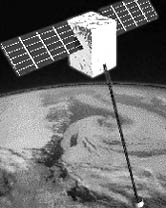Down to Earth
 easy . Just call Tethers Unlimited, a us -based company, whose areas of expertise include "hauling' all those dead satellites back home, either for a burial or for resurrection. This Washington-based company claims that the method it has developed is not only simple, but economically viable too. In fact, the company has booked a launch on a Russian rocket in late 1998 or early 1999 to test its special tether.
easy . Just call Tethers Unlimited, a us -based company, whose areas of expertise include "hauling' all those dead satellites back home, either for a burial or for resurrection. This Washington-based company claims that the method it has developed is not only simple, but economically viable too. In fact, the company has booked a launch on a Russian rocket in late 1998 or early 1999 to test its special tether.
In theory, satellites should be able to generate power from a long tether. However, when the us National Aeronautics and Space Administration ( nasa ) launched a satellite to test the idea two years ago in 1996, the tether was severed after just six hours, probably by a small piece of space junk. The new tether has a web-like structure which will enable it to withstand such damage in future, and the company plans to use it to brake an ailing satellite, causing it lose height and fall to Earth. Over the next few years, hundreds of satellites will be injected into low-Earth orbit for mobile phone communications. And given the rather poor performance record of these, satellite retrieval is certain to get you good money.
Using a rocket to take a satellite out of orbit would mean carrying extra fuel into space equivalent to between five to 15 per cent of the satellite's mass. The fuel needed to launch this added mass would mean several extra million dollars added to the launch costs.
The tether, which could be up to 10 kilometres in length, will generate electric currents of up to one ampere as it cuts the Earth's magnetic field. It is the interaction between the current in the tether and the Earth's magnetic field that would brake a satellite. A spokesperson for Tethers Unlimited claims that a tether would account for only two per cent of the satellite's mass and would be able to replace a rocket for about a tenth of the price. The company's Terminator Tether is a multiline cable with a ballast mass of a few kilograms on one end. The tether would be unwound like a bobbin in a cotton factory. It would be pulled taut by the gravity differences at varying altitudes. Once a tether had been unwound, it would take a satellite out of a 780-kilometre-high orbit in less than a year. Left to natural circumstances, the same process would require at least a century.
The design of the tether consists of three parallel lines with crossed wires zigzagging between. Unlike a single strand, this webbing can resist the constant bombardment of meteorites and space junk.
Tethers Unlimited, which has a us $60,00,000 contract from nasa to explore this concept, has hired a Scottish knitwear firm to develop the design.
Related Content
- Judgment of the National Green Tribunal regarding pollution of river Yamuna at Agra and Mathura-Vrindavan due to discharge of untreated sewage in the river, 24/04/2024
- State of global environmental governance 2023
- State of India's environment 2024
- Climate India 2023: an assessment of extreme weather events
- Debates that matter
- State of India’s environment 2023
